A) Raise wages to the level of the players' MRP.
B) Raise wages to competitive levels.
C) Reduce the supply of professional players and thus increase wages.
D) Raise wages above the level of the players' MRP.
Correct Answer

verified
Correct Answer
verified
True/False
If a union achieves above-equilibrium wages for its membership, the wages of nonunion workers will generally suffer.
Correct Answer

verified
Correct Answer
verified
Multiple Choice
The decline in unionization can be explained by all of the following except
A) Increased worldwide investment barriers.
B) Increased global competition.
C) Downsizing of major corporations.
D) A relative decline in manufacturing.
Correct Answer

verified
Correct Answer
verified
Multiple Choice
Workers with a particular skill are represented by
A) Craft unions.
B) Skill unions.
C) Market unions.
D) Industrial unions.
Correct Answer

verified
Correct Answer
verified
Multiple Choice
When a strike or a lockout occurs,
A) Only labor suffers.
B) Both labor and management suffer.
C) Only management suffers.
D) Management suffers from a strike while labor suffers from a lockout.
Correct Answer

verified
Correct Answer
verified
Multiple Choice
The In the News article titled "Free Agents in Sports: A Threat to Monopsony" states, "Individual players were permitted to negotiate with only one team." The reserve clause in player contracts gave franchise owners in the labor market essentially
A) A bilateral monopoly.
B) A monopoly.
C) A monopsony.
D) A competitive market.
Correct Answer

verified
Correct Answer
verified
Multiple Choice
Public sector unions now
A) Represent a smaller percentage of workers than private sector unions.
B) Are growing at a smaller rate than private sector unions.
C) Represent over five times the percentage of workers in private sector unions.
D) Are illegal in the United States.
Correct Answer

verified
Correct Answer
verified
Multiple Choice
An oligopsony exists if
A) Only a few firms produce most of the industry's output.
B) Only a few firms account for most of the industry's employment.
C) Only one firm accounts for most of the industry's employment.
D) There is no buyer concentration in the labor market.
Correct Answer

verified
Correct Answer
verified
True/False
From the 1930s until today, unions have experienced particularly fast growth in the United States.
Correct Answer

verified
Correct Answer
verified
Multiple Choice
Refer to Figure 31.3 for a competitive labor market.  A shift in labor supply from S1 to S2 could be caused by:.
A shift in labor supply from S1 to S2 could be caused by:.
A) An increase in the wage rate.
B) The unionization of another labor market.
C) An increase in the price of the product being produced.
D) An increase in the price of machinery used in the production of the product.
Correct Answer

verified
Correct Answer
verified
Multiple Choice
The United Farm Workers have been unsuccessful for decades in their attempts to organize California's strawberry pickers because the workers
A) Know that replacement workers are readily available.
B) Don't care about earning higher wages.
C) Don't understand English.
D) Are members of a union shop.
Correct Answer

verified
Correct Answer
verified
Multiple Choice
The unionization rate in the United States has been
A) Increasing for the last 5 years.
B) Declining for approximately 30 years.
C) Declining for approximately 15 years.
D) Declining for over 40 years.
Correct Answer

verified
Correct Answer
verified
True/False
In a monopoly labor market, the optimal union wage can be read off the marginal revenue product curve.
Correct Answer

verified
Correct Answer
verified
True/False
A monopsonist will hire fewer workers at a lower wage rate than would prevail in a competitive market.
Correct Answer

verified
Correct Answer
verified
Multiple Choice
The unionization ratio represents the
A) Percentage of the total labor force belonging to unions.
B) Market power of unions relative to the market power of nonunion labor.
C) Proportion of industries that are dominated by unions.
D) Annual percentage growth in the total number of unions.
Correct Answer

verified
Correct Answer
verified
Multiple Choice
The percentage of the labor force that belongs to a union is known as the
A) Union share ratio.
B) Unionization ratio.
C) Union participation ratio.
D) Unionized percentage ratio.
Correct Answer

verified
Correct Answer
verified
Multiple Choice
A monopsonist must pay a higher net wage rate to hire additional workers because as a single
A) Seller, it has market power.
B) Seller, it does not have to compete with other firms for customers.
C) Buyer in the market, it faces an upward-sloping supply curve for labor.
D) Buyer in the market, it faces a flat supply curve for labor.
Correct Answer

verified
Correct Answer
verified
True/False
Labor markets where power exists on both the demand side and the supply side are rare.
Correct Answer

verified
Correct Answer
verified
Multiple Choice
One World View table titled "Union Membership" shows the unionization rates for several countries including the United States. The decline in the U.S. unionization rate is the result of
A) A relative decline in manufacturing.
B) A relative decline in service industries.
C) The growth of large firms relative to small firms.
D) The decline in worldwide competition.
Correct Answer

verified
Correct Answer
verified
Multiple Choice
 Refer to Figure 31.2. What is the competitive level of wages and employment?
Refer to Figure 31.2. What is the competitive level of wages and employment?
A) $11 per hour and 50 workers.
B) $9 per hour and 40 workers.
C) $7 per hour and 50 workers.
D) $6 per hour and 40 workers.
Correct Answer

verified
Correct Answer
verified
Showing 61 - 80 of 145
Related Exams